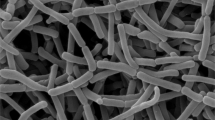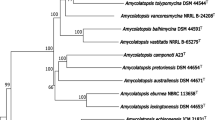Abstract
A novel actinomycete, designated strain KLBMP 1262T, was isolated from a coastal plant Dendranthema indicum (Linn.) Des Moul collected from the coastal region of Nantong, Jiangsu Province, in east China and was studied in detail for its taxonomic position. Phylogenetic analysis based on the 16S rRNA gene sequence revealed that strain KLBMP 1262T is a member of the genus Amycolatopsis. The 16S rRNA gene sequence similarity indicated that strain KLBMP 1262T is most closely related to Amycolatopsis sulphurea DSM 46092T (97.96 %), Amycolatopsis ultiminotia RP-AC36T (97.50 %) and Amycolatopsis jejuensis N7-3T (97.44 %); similarity to other type strains of the genus Amycolatopsis was less than 97.0 %. The organism was determined to have chemical and morphological features consistent with its classification in the genus Amycolatopsis such as meso-diaminopimelic acid as the diagnostic diamino acid in the cell wall peptidoglycan and arabinose and galactose as the diagnostic sugars. The predominant menaquinone was determined to be MK-9 (H4). The polar lipids detected were phosphatidylmethylethanolamine, phosphatidylethanolamine, an unknown aminophospholipid, two unknown glycolipids and several unknown lipids. The major fatty acids were found to be C16:0, iso-C16:0 and iso-C15:0. DNA–DNA relatedness data, together with phenotypic differences, clearly distinguished the isolate from its closest relatives. On the basis of these phenotypic and genotypic data, the isolate is considered to represent a novel species, for which the name A. jiangsuensis sp. nov. is proposed. The type strain is KLBMP 1262T (=KCTC 19885 T = NBRC 108679T).


Similar content being viewed by others
References
Collins MD, Pirouz T, Goodfellow M, Minnikin DE (1977) Distribution of menaquinones in actinomycetes and corynebacteria. J Gen Microbiol 100:221–230
Ezaki T, Hashimoto Y, Yabuuchi E (1989) Fluorometric deoxyribonucleic acid-deoxyribonucleic acid hybridization in microdilution wells as an alternative to membrane filter hybridization in which radioisotopes are used to determine genetic relatedness among bacterial strains. Int J Syst Bacteriol 39:224–229
Felsenstein J (1981) Evolutionary trees from DNA sequences: a maximum likelihood approach. J Mol Evol 17:368–376
Felsenstein J (1985) Confidence limits on phylogenies: an approach using the bootstrap. Evolution 39:783–789
Gordon RE, Barnett DA, Handerhan JE, Pang CH-N (1974) Nocardia coeliaca, Nocardia autotrophica, and the Nocardin strains. Int J Syst Bacteriol 24:54–63
Groth I, Schumann P, Rainey FA, Martin K, Schuetze B, Augsten K (1997) Demetria terragena gen. nov., sp. nov., a new genus of actinomycetes isolated from compost soil. Int J Syst Bacteriol 47:1129–1133
Hasegawa T, Takizawa M, Tanida S (1983) A rapid analysis for chemical grouping of aerobic actinomycetes. J Gen Appl Microbiol 29:319–322
He L, Li W, Huang Y, Wang L, Liu ZH (2005) Streptomyces jietaisiensis sp. nov., isolated from soil in northern China. Int J Syst Evol Microbiol 55:939–944
Kelly KL (1964) Color-name charts illustrated with centroid colors. Inter-Society Color Council-National Bureau of Standards, Chicago
Kim OS, Cho YJ, Lee K, Yoon SH, Kim M, Na H, Park SC, Jeon YS, Lee JH, Yi H, Won S, Chun J (2012) Introducing EzTaxon-e: a prokaryotic 16S rRNA gene sequence database with phylotypes that represent uncultured species. Int J Syst Evol Microbiol 62:716–721
Kluge AG, Farris FS (1969) Quantitative phyletics and the evolution of anurans. Syst Zool 18:1–32
Kurup PV, Schmitt JA (1973) Numerical taxonomy of Nocardia. Can J Microbiol 19:1035–1048
Lechevalier MP, Lechevalier HA (1970) Chemical composition as a criterion in the classification of aerobic actinomycetes. Int J Syst Bacteriol 20:435–443
Lechevalier MP, De Bièvre C, Lechevalier HA (1977) Chemotaxonomy of aerobic actinomycetes: phospholipid composition. Biochem Syst Ecol 5:249–260
Lechevalier MP, Prauser H, Labeda DP, Ruan JS (1986) Two new genera of nocardioform actinomycetes: Amycolata gen. nov. and Amycolatopsis gen. nov. Int J Syst Bacteriol 36:29–37
Lee SD (2009) Amycolatopsis ultiminotia sp. nov., isolated from rhizosphere soil, and emended description of the genus Amycolatopsis. Int J Syst Evol Microbiol 59:1401–1404
Mesbah M, Premachandran U, Whitman WB (1989) Precise measurement of the G+C content of deoxyribonucleic acid by high-performance liquid chromatography. Int J Syst Bacteriol 39:159–167
Minnikin DE, Collins MD, Goodfellow M (1979) Fatty acid and polar lipid composition in the classification of Cellulomonas, Oerskovia and related taxa. J Appl Bacteriol 47:87–95
Minnikin DE, Hutchinson IG, Caldicott AB, Goodfellow M (1980) Thin layer chromatography of methanolysates of mycolic acid-containing bacteria. J Chromatogr 188:221–233
Qin S, Li J, Chen HH, Zhao GZ, Zhu WY, Jiang CL, Xu LH, Li WJ (2009) Isolation, diversity, and antimicrobial activity of rare actinobacteria from medicinal plants of tropical rain forests in Xishuangbanna, China. Appl Environ Microbiol 75:6176–6186
Saitou N, Nei M (1987) The neighbor-joining method: a new method for reconstructing phylogenetic tree. Mol Biol Evol 4:406–425
Shirling EB, Gottlieb D (1966) Methods for characterization of Streptomyces species. Int J Syst Bacteriol 16:313–340
Stackebrandt E, Rainey FA, Ward-Rainey NL (1997) Proposal for a new hierarchic classification system, Actinobacteria classis nov. Int J Syst Bacteriol 47:479–491
Takahashi Y (2001) Family Pseudonocardiaceae. In: The Society for Actinomycetes Japan (ed) Identification manual of Actinomycetes, The Business Centre for Academic Societies, Tokyo, pp 227–239
Tamura K, Peterson D, Peterson N, Stecher G, Nei M, Kumar S (2011) MEGA5: molecular evolutionary genetics analysis using maximum likelihood, evolutionary distance, and maximum parsimony methods. Mol Biol Evol 28:2731–2739
Tan GYA, Goodfellow M (2012) Genus IV. Amycolatopsis (Lechevalier, Prauser, Labeda and Ruan 1986) Lee 2009, 1403VI. In: Goodfellow M, Kämpfer P, Busse HJ, Trujillo ME, Suzuki KI, Ludwig W, Whitman WB (eds) Bergey’s Manual of Systematic Bacteriology, 2nd edn, vol. 5. The Actinobacteria, Springer, Berlin, pp 1335–1336
Tang SK, Wang Y, Guan TW, Lee JC, Kim CJ, Li WJ (2010) Amycolatopsis halophila sp. nov., a halophilic actinomycete isolated from a salt lake. Int J Syst Evol Microbiol 60:1073–1078
Waksman SA (1967) The Actinomycetes. A Summary of Current Knowledge. Ronald Press, New York
Wayne LG, Brenner DJ, Colwell RR, Grimont PAD, Kandler O, Krichevsky MI, Moore LH et al (1987) International 21 committee on systematic bacteriology. Report of the ad hoc committee on reconciliation 22 of approaches to bacterial systematics. Int J Syst Bacteriol 37:463–464
Williams ST, Goodfellow M, Alderson G (1989) Genus Streptomyces Waksman and Henrici 1943, 339AL. In: Williams ST, Sharpe ME, Holt JG (eds) Bergey’s manual of systematic bacteriology, vol 4. Williams & Wilkins, Baltimore, pp 2452–2492
Xu P, Li WJ, Tang SK, Zhang YQ, Chen GZ, Chen HH, Xu LH, Jiang CL (2005) Naxibacter alkalitolerans gen. nov., sp. nov., a novel member of the family ‘Oxalobacteraceae’ isolated from China. Int J Syst Evol Microbiol 55:1149–1153
Zucchi TD, Tan GYA, Goodfellow M (2012) Amycolatopsis thermophila sp. nov. and Amycolatopsis viridis sp. nov., novel thermophilic actinomycetes isolated from Australian soil. Int J Syst Evol Microbiol 62:168–172
Acknowledgments
The authors are grateful to Prof. Iain C. Sutcliffe for his valuable comments on the manuscript. This research was partially supported by National Natural Science Foundation of China (31000005, 31101502), the Program of Natural Science Foundation of the Jiangsu Higher Education Institutions of China (10KJB180008, 11KJD210002), the Project Funded by the Priority Academic Program Development of Jiangsu Higher Education Institutions (PAPD) and Natural Science Foundation by Xuzhou City (No. XZZD1004).
Author information
Authors and Affiliations
Corresponding authors
Additional information
Ke Xing and Wei Liu contributed equally to this study.
Electronic supplementary material
Below is the link to the electronic supplementary material.
Rights and permissions
About this article
Cite this article
Xing, K., Liu, W., Zhang, YJ. et al. Amycolatopsis jiangsuensis sp. nov., a novel endophytic actinomycete isolated from a coastal plant in Jiangsu, China. Antonie van Leeuwenhoek 103, 433–439 (2013). https://doi.org/10.1007/s10482-012-9823-y
Received:
Accepted:
Published:
Issue Date:
DOI: https://doi.org/10.1007/s10482-012-9823-y




